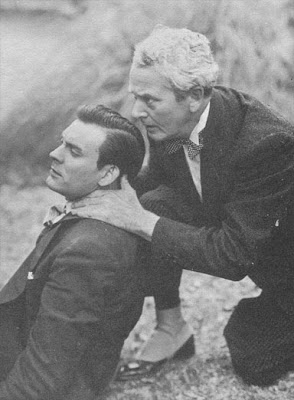Starring: Gin Mart, Anita Todesco, Maureen Brown, and Luciano Gasper
Director: Dino Tavella
Rating: Three of Ten Stars
A homicidal maniac in SCUBA gear abducts women from the streets of Venice and brings them to his secret lair under the canals where he embalms them after changing into a skull mask and monk robes. Will the only intelligent man in the city (Mart) stop the killing before his overly inquisitive girlfriend becomes the next victim (Todesco)?
"The Embalmer" dates from the late 1960s, but it feels more like something from someone studying at the feet of such master hacks as William Beaudine and William Nigh but who either didn't pay attention or who is nearly devoid of talent. In a similar vein, it feels like it was made by someone who wanted to make a movie like the 1962 hit Mario Bava's "The Girl Who Knew Too Much" or the horror-tinged Val Lewton oddities from RKO twenty years earlier, but who didn't pay attention to what made these movies from classier directors work either.
This movie features the same sort of long-on-looks-but-short-on-personality hero and the stupid, indifferent cops that were mainstays in so many Beaudine and Nigh directed films, as well as an outrageous plot just like many of their movies. But this film is slower and more repetitive than either the worst Beaudine or Nigh effort, with the lead-up to the abductions and the freeze-frame that identifies the victim becoming tiresome by the third time we are walked through the process (just in case we didn't catch it the first two), and the supposedly spooky ramblings of the girl-collecting mad man getting longer and stupider as the film progresses instead of shorter and creeper. Basically, it's a non-thrilling thriller in just about every way.
In trying to be like Bava or Lewton, Tavella only manages to make the mundane world existing around the horrific so mundane that it's downright boring, while consistently failing to deliver anything but flatly lit scenes filmed in an uninspired fashion. And what suspense there might be in a scene is usually dispelled by some of the most inappropriate jazzy soundtrack music you're likely to encounter.
And then there's the obligatory musical number at the halfway point of the film. Even that is painful to sit through.
For all that is bad with this movie, Tavella does start to get with the horror movie and/or suspense film program as we reach the final 10-15 minutes of the roughly 80-minute running time. The chases in the madman's underground lair, the final fate of the girlfriend, and even the final square-off between the hero and the killer all feel like they might belong in a different movie--except for the crappy soundtrack music, but even that is deployed a little more effectively here. All the moodiness that has been lacking up to this point is suddenly present on the screen, and our patience for sticking around is rewarded.
That said, the pay-off may not be good enough to waste an hour of your life on. Supposedly there's an edit out there that runs about 50 minutes. If it was cut by someone with skill and talent, maybe they managed to make the film worthwhile, although my experience has been that such hackery often makes things worse.
"The Embalmer" is available in multiple DVD editions on its own, or in a couple of different multi-packs. The only reason for checking it out would be if you're interested in examining movies that feature elements of what eventually became the "slasher movie" genre, so your best bet is to acquire it in a multi-pack and consider it a "bonus feature".
Note: It's entirely possible that I am being unfair to Dino Tavella by assuming he was trying to copy/pay homage to other filmmakers. It's entirely possible that his incompetence was born entirely of his own inspiration. This is one of two movies that Tavella wrote and directed in 1965. He died at the age of 48 in 1969, and I could learn little else about him during a quick web-search.



































.jpg)






.jpg)
